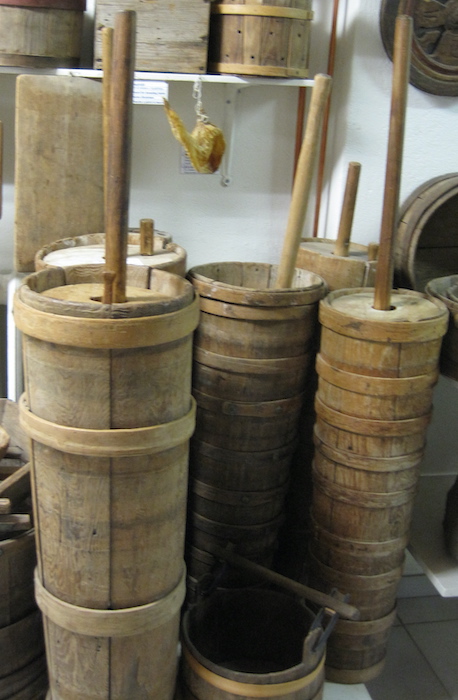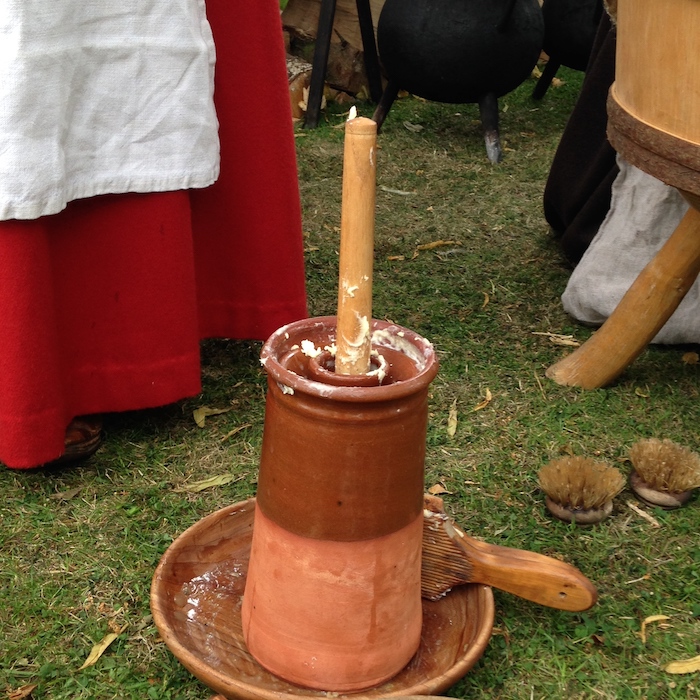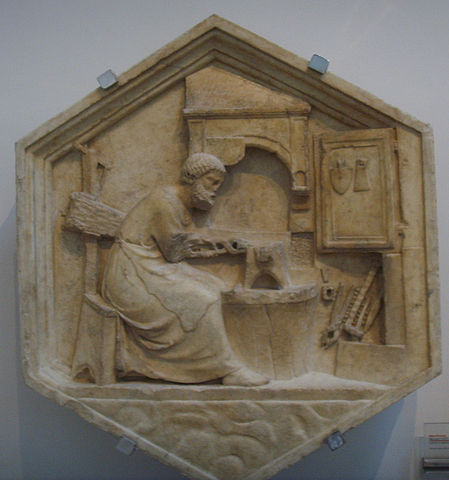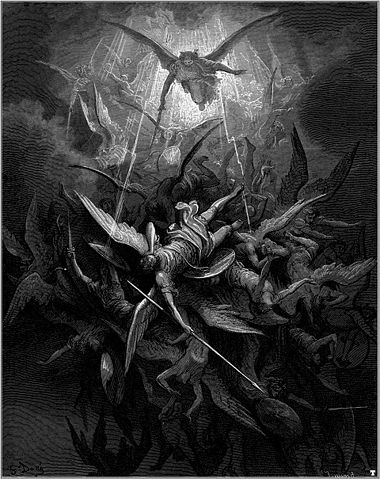Commentary for Exeter Riddle 54
MEGANCAVELL
Date: Thu 22 Feb 2018Matching Riddle: Exeter Riddle 54
For this post, we’re going to experiment with a new commentary style. I’m all for collaboration, so Andrea Di Carlo and I are going to take turns talking about Riddle 54. Will it work? You can be the judge of that! (but don’t actually judge us, because our egos are too fragile for all that)
Let’s start with the basics: what are the “obscene” riddles and how does Riddle 54 fit in?
Andrea: Over the last few decades, the riddles of the Exeter Book have attracted a lot of scholarship, especially after the critical reviews carried out by Mercedes Salvador-Bello, Glenn Davis, Patrick Murphy and Ruth Evans. If, in 1910, Frederick Tupper had rejected any type of unsavoury interpretation and overruled the category “obscene riddles,” George Phillip Krapp and Elliott van Kirk Dobbie later made allowances for euphemistic wording and images, and acknowledged that obscene content had to be taken into account.
Riddle 54 perfectly fits into this category because its imagery is certainly problematic and far from ambiguous. Krapp and Dobbie solve the riddle as “churn” (page 188), relying on the earlier suggestion of Moritz Trautmann. The backdrop of the obscene riddles tends to be mundane, as is the case with the start of Riddle 54: readers follow the progress of a young man travelling toward a woman, only to hear that, when he arrives in the corner where the woman stands, he thrusts stiþes nathwæt (line 5b) (something stiff) under her girdle.
Megan: Okay, so pretty obviously euphemistic then. While we can translate nathwæt as just “something,” the nat part of the compound is actually from the contracted verb, nytan, that is: ne + witan (to know not). In other words, it means something like “a stiff know-not-what.” This is a pretty obvious attempt to avoid saying what it is the poet means, which just screams euphemism! Nathwæt also appears in Riddle 45 and Riddle 61, both of which are interested in sex in their own right.
So, the word is a dead giveaway that we’re definitely looking at a rude riddle.
Andrea: What else are we readers supposed to think? It’s pretty clear that the anonymous riddle-composer is showing us a short scene of sexual intercourse (suspicion is only aroused further by the use of wagedan in line 6, which means “shake” or “shag,” and by the tillic esne (capable servant) hastening in lines 7-8a). This idea is emphasised by Murphy (pages 184-195) and Evans (page 28), whose interpretations of the text are based upon these sequences of obscene and potentially aggressive images: the hyse (young man) of line 1a worhte his willan (line 6a) (worked his will), while the female figure stands there.
Megan: So, is this a disturbing example of sex where the woman is simply the object of the man’s desire, or could there be something more going on here? Well, Murphy actually provides an alternative interpretation to the two-people-having-sex-in-a-corner reading. He reminds us that we shouldn’t confuse the grammatical and natural gender of pronouns – that is, the poet never actually describes the female character (while other rude riddles, like Riddle 25 and Riddle 45, do include more elaborate descriptions), and so she might not be a woman at all.
The female pronouns (hio/hie/hire, i.e. she/her) could also be applied to objects that are grammatically feminine…which, coincidentally, Old English cyrn is. So, if we read every reference to “she/her” as “it” instead and swap the translation “belt” for “girdle,” then maybe we’re actually witnessing a young man working his will on his “capable servant” all by himself. This certainly makes the joke a lot less aggressive and so, I’d say, funnier. And it just gets more amusing when we read this potential masturbation scene alongside the more wholesome butter churn interpretation.
Andrea: Yes! We should always expect some sort of a twist in the Old English riddles. And the turning point takes place in the last line, where our sexual assumptions are quashed and we’re brought back to a reality that both encourages and rejects the double entendre. In lines 11-12 we hear that under the woman’s girdle (or man’s belt) grows what men mid feo bicgað (buy with money). Surely, there’s no euphemistic way to read this financial transaction?! With these lines, the sexual reading of Riddle 54 is dispelled and we find that the author was simply referring to the making of butter in a churn.

Here are some Icelandic butter churns on display at a museum Megan once visited. Sadly, she has no idea where she saw these bad boys. Possibly in the south of Iceland?
Megan: If we accept that we’re hearing about a cyrn or churn, then the riddle also provides a useful corrective to any food prep-based gender assumptions we might want to make. It’s tempting to assume that all food production was a female task in early medieval England, and certainly much of women’s work did involve preparing food. We do, for example, have a reference to a female cheese-maker whose duties also involved making butter from the eleventh-century law-text known as the Rectitudines Singularum Personarum (Rights of Different People).
It reads: cyswyrhtan gebyreð hundred cyse, & þæt heo of wringhwæge buteran macige to hlafordes beode (a hundred cheeses are allotted to the cheese-maker, and that she makes butter from the whey pressed out of cheese for the lord’s table (Liebermann, vol. 1, page 451, no. 16). The feminine ending attached to the cheese-maker here tells us that she’s female. But the method of preparation – of cheese first and then butter – also tells us that the raw material is likely sheep’s milk (Banham and Faith, pages 111-12). Could this be important?
Because, after all, the person doing the churning here in Riddle 54 is definitely male. And he’s not the only man to own up to doing a bit of churning on the side. In fact, he reminds me of the shepherd in Ælfric’s Colloquy (a dialogue-style, bilingual text aimed at teaching Latin to youngsters in early medieval England). After the teacher asks the pupil assigned the role of shepherd what work he does, the pupil replies that he watches over the sheep in their pastures, milks them, etc., and finishes with the statement: ge cyse ge buteran ic do, ond ic eom getrywe hlaforde minum (I make both butter and cheese, and I am faithful to my lord) (Ælfric, page 22). So, perhaps it makes sense to think of farming as the task of a household rather than dividing specific bits and pieces of it down gender lines.
Someone had better tell the be-skirted churners at the Durham Medieval Family Fun Weekend I attended last year to get their male collaborators to help out a bit more!

The butter churn on show at the Medieval Family Fun Weekend, Durham Cathedral, August 2015.
So, we’ve heard about the various ways of reading this riddle’s sexual encounter, and we’ve heard a bit about churning butter (which is really tiring, hard work, by the way!). But what’s the take-home point of this riddle, then?
Andrea: I think it’s important to note that the riddles capitalise on double entendre and dubiety, because it’s in their nature to intellectually challenge and defy readers. “No sex, please, we’re Anglo-Saxons,” as Hugh Magennis famously wrote some time ago! I’d argue that sexual imagery or sexually laden content in the riddles conveys a more domestic and less remote picture of the past, while also challenging commonplaces about sexual life in medieval Europe.
In the end, mystifying or nonplussing the audience is the main target of the riddle-composer and this one perfectly manages to play his/her cards right: the poet tricks us into believing we’re viewing sexual intercourse in the opening lines, only to undercut our assumptions at the end by making it clear that it wasn’t sex at all, but the making of something that can be bought and sold (butter, of course!). And, after all, this is the nature of riddles, to engage participants in a mental and intellectual process that’s supposed to enrich their knowledge, as Krapp and Dobbie maintain. Or, in this case, to baffle them!
References and Suggested Reading:
Ælfric of Eynsham. Ælfric’s Colloquy. Edited by G.N. Garmonsway. London: Methuen, 1939.
Banham, Debby, and Rosamond Faith. Anglo-Saxon Farms and Farming. Oxford: Oxford University Press, 2014.
Davis, Glenn. “The Exeter Book Riddles and the Place of Sexual Idiom in Old English Literature.” In Medieval Obscenities. Edited by Nicola McDonald. York: York Medieval Press, 2006, pages 39-54.
Evans, Ruth, ed. A Cultural History of Sexuality in the Middle Ages. London: Bloomsbury, 2014.
Krapp, George Philip, and Elliott Van Kirk Dobbie, eds. The Exeter Book, Anglo-Saxon Poetic Record, vol. 3. New York: Columbia University Press, 1936.
Liebermann, F., ed. Die Gesetze der Angelsachsen. 3 vols. Halle: Max Niemeyer, 1903-16.
Magennis, Hugh. “‘No Sex Please, We’re Anglo-Saxons’? Attitudes to Sexuality in Old English Prose and Poetry.” Leeds Studies in English, vol. 26 (1995), pages 1-27.
Murphy, Patrick J. Unriddling the Exeter Riddles. University Park: Pennsylvania State University Press, 2011.
Salvador-Bello, Mercedes. “The Key to the Body: Unlocking Riddles 42-46.” In Naked Before God: Uncovering Body in Anglo-Saxon England. Edited by Benjamin C. Withers and Jonathan Wilcox. Morgantown: West Virginia University Press, 2003, pages 60-96.
Trautmann, Moritz. “Alte und Neue Antworten auf altenglische Rätsel.” Bonner Beiträge zur Anglistik, vol. 19 (1905), pages 167-215.
Tupper, Frederick, Jr., ed. The Riddles of the Exeter Book, Boston: Ginn, 1910.
Tags: anglo saxon exeter book riddles old english solutions riddle 54 andrea di carlo
Related Posts:
Commentary for Exeter Riddle 25
Commentary for Exeter Riddle 45
Commentary for Exeter Riddle 61




Commentary for Exeter Riddle 53
MEGANCAVELL
Date: Tue 06 Feb 2018Matching Riddle: Exeter Riddle 53
This commentary comes to us once again from Sharon Rhodes of the University of Rochester. Congratulations on successfully defending your thesis this week, Sharon!
There have been three major solutions proposed for Riddle 53: battering ram, gallows, and cross. Battering ram seems the most literal — something that was a once tree, but was then chopped down, outfitted with metal fittings and used to storm castles. But gallows and cross stretch our perspectives. In any case, the development of these modern solutions has a history.
In 1859, F. Dietrich solved Riddle 53 as “battering ram.” The iron work involved in battering rams allows us to read line 6 quite literally: deope gedolgod, dumb in bendum (deeply wounded, silent in his shackles). Cross and gallows are less clear and more dependent on context: there are multiple ways of constructing a gallows, crucifix or otherwise. The first solution also allows for an easy reading of lines 8b through 10a: Nu he fæcnum weg / þurh his heafdes mægen hildegieste / oþrum rymeð (Now he, through the might of head, clears the path to another treacherous enemy). If the solution is “battering ram,” then this is a simple description of attacking and then plundering a castle.
Photo of a battering ram (by eltpics) from Flickr (licence: CC BY-NC 2.0).
But “battering ram” is a solution that is contextually lacking: there were no battering rams in early medieval England! At least, according to Craig Williamson, “there is no archaeological evidence for the existence of an Anglo-Saxon battering ram,” which makes sense when we recall that there were no early medieval castles to lay siege to with a battering ram (page 297). Of course, there’s no reason to think that the early English couldn’t comprehend battering rams and Aldhelm’s Riddle 86 — a Latin riddle written in early medieval England — suggests a battering ram at least twice (Williamson, page 297):
Sum namque armatus rugosis cornibus horrens.
Herbas arvorum buccis decerpo virentes,
Et tamen astrifero procedens agmine stipor;
Culmina caelorum quae scadunt celsa catervis.
Turritas urbes capitis certamine quasso
Oppida murorum prosternens arcibus altis.
Induo mortales retorto stamine pepli;
Littera quindecima praestat quod pars domus adsto.
(Aldhelm, ed. by Juster, pages 52-3)
(Yes, armed with wrinkled horns, I’m quite a fright. / I chew huge mouthfuls of the meadow grass, / Yet starry swarms escort me as I pass; / They rise in hordes to Heaven’s highest height. / Headstrong, I bang the turrets of the town / So its tall fortress walls will tumble down. / With twisted thread I fill man’s clothing needs; / I’m right at home if letter fifteen leads.)
Photo of a battering ram head (by Clarinetlover) from Wikimedia Commons (licence: CC BY-SA 3.0).
However, while Aldhelm’s riddle dances between the idea of a ram (male sheep) and the siege weapon — the Latin word aries can refer to either — there’s no real sheep reference in Exeter Riddle 53, unless you consider sheep inveterate thieves of the night.
Photo of a Gute ram (by Oskari Löytynoja) from Wikimedia Commons (licence: CC BY 3.0).
So too, the imagery of Riddle 53 is strikingly similar to that of the famous Old English poem The Dream of the Rood. For instance, the dreamer describes the Rood tree as forwundod mid wonnum (sorely wounded with wounds) at line 14, which is reminiscent of Riddle 53’s line 7: wriþen ofer wunda, wonnum hyrstum (racked all over with wounds, adorned with dark ornaments). In fact, Jonathan Wilcox reads Riddle 53 as an analog of The Dream of the Rood and, accordingly, suggests the solution of “gallows,” and Andy Orchard reads The Dream of the Rood as a riddle writ large and, consequently, solves 53 as “cross”: a very specific gallows.
Image of crows and gallows from Bewick, page 71.
As Orchard points out, The Dream of the Rood uses the word beam — which occurs in Riddle 53 — with a number of meanings. Beam can mean “tree,” “gallows” or “sunbeam” — the cross’s function as Christ’s retainer — so this singular word accounts for the rood-tree’s three states, a trinity, so to speak. Through its homonyms, beam points to multiple aspects of the rood-tree’s function and identity. And beam of course is exactly how we’re introduced to the solution of Riddle 53 in line 1: Ic seah on bearwe beam hlifian (I saw a tree towering in a wood).
Photo of a cross (by Ian Britton) from Flickr (licence: CC BY-NC 2.0).
Each of these solutions — battering ram, gallows and cross — reconfirms that the Exeter riddles are poems that force us to consider the parallels between different things by viewing them from unfamiliar perspectives. John D. Niles points out that the cross is a gallows — an instrument of execution — and a source of life in the Christian tradition (page 147; note that Niles suggests the Old English solution of gealg-treow (gallows-tree)).
Photo of Biogradska forest in Montenegro (by Snežana Trifunović) from Wikimedia Commons (licence: CC BY-SA 3.0)
Perhaps most significantly, Riddle 53 stands with The Dream of the Rood and other riddles of torture in forcing the audience to consider the world from the point of view of what humanity typically views as “raw materials” for our built world. As Jennifer Neville points out, “in Exeter Book Riddles 53 and 88, [. . .] a tree and the antler of a deer, both dwelling happily and naturally in the forest (bearu, holt), are seized, removed from their environment, wounded and used by human beings; as tools, as battering rams and ink-horns” (page 115). These things “are forced on wera æhtum ‘into the possessions of men’ (Exeter Book Riddle 88, 23b)” (page 115).
If we keep “battering ram” while adding “cross” and “gallows,” then we can start exploring the idea of Christ and the crucifix as invaders. Perhaps this is an oblique reference to the harrowing of hell — when Christ invaded hell to bring salvation to the righteous who died before his crucifixion, thereby “stealing” souls from Satan. As with so many of the Exeter riddles, no one solution is totally satisfying; it’s the collection of possible answers that allows us to see a tree in a forest for all of the potential lives it may lead after its felling.
References and Suggested Reading:
Aldhelm. Saint Aldhelm’s ‘Riddles.’ Edited and translated by A. M. Juster. Toronto: University of Toronto Press, 2015.
Bewick, Thomas. A History of British Birds. Vol. I (Newcastle: R. Ward and Sons, 1885) [Memorial Edition]
Bitterli, Dieter. Say What I Am Called. Toronto: University of Toronto Press, 2009 (esp. pages 151-69).
Neville, Jennifer. Representations of the Natural World in Old English Poetry. Cambridge: Cambridge University Press, 1999.
Niles, John D. Old English Enigmatic Poems and the Play of the Texts. Turnhout: Breopols, 2006.
Orchard, Andy. “The Dream of the Rood: Cross-References.” In New Readings in the Vercelli Book. Edited by Samantha Zacher and Andy Orchard. Toronto: University of Toronto Press, 2015, pages 225-53.
Wilcox, Jonathan. “New Solutions to Old English Riddles 17 and 53.” Philological Quarterly, vol. 69 (1990), pages 393-408.
Williamson, Craig. The Old English Riddles of the Exeter Book. Chapel Hill, NC: University of North Carolina Press, 1977.
Tags: anglo saxon exeter book riddles old english solutions riddle 53 sharon rhodes
Related Posts:
Commentary for Exeter Riddle 53
Commentary for Exeter Riddle 55
Commentary for Exeter Riddle 73